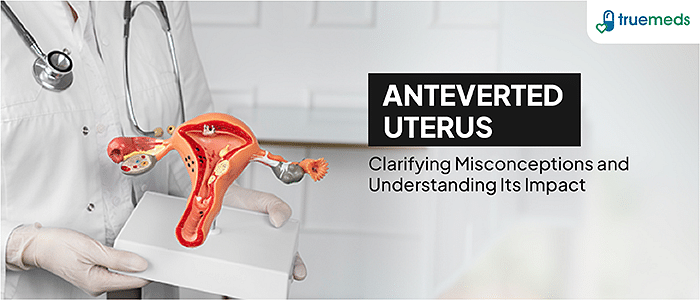Anteverted Uterus
Last updated on : 30 Sep, 2024
Read time : 9 min
Introduction
The uterus, a vital organ in the female reproductive system, plays a crucial role in menstruation, pregnancy, and childbirth. Its anatomy includes the cervix, which opens into the vagina, the body, which houses the developing fetus during pregnancy, and the fundus, the top portion opposite the cervix. The uterus can adopt various positions in the pelvic cavity, which can influence the way it functions and interacts with other pelvic organs.
These positions include anteverted, retroverted, and midline. The most common position is the Anteverted Uterus, where it tilts forward towards the bladder. Understanding the different positions of the uterus is essential as it helps in diagnosing and treating various gynecological conditions effectively. By knowing the position of the uterus, healthcare providers can better address symptoms related to menstrual irregularities, pain, and fertility issues, ensuring that women receive the most appropriate and effective care.
What is Anteverted Uterus?
An Anteverted Uterus is a forward-tilted position of the uterus, where it leans towards the bladder. This is the most common uterine position and is seen in approximately 70% to 75% of women. This position of the uterus is considered to be normal. Your uterus can tilt at varying ranges. An Anteverted Uterus approaches your uterus, tilts forward at your cervix and points towards your abdomen. You’re normally born with your uterus in this position, similar to the colouration of your skin and the form of your face. Typically, the size of an Anteverted Uterus is about 7.6 cm in length, 4.5 cm in width, and 3 cm in thickness. Despite its position, an Anteverted Uterus usually does not affect bladder function or cause frequent urination. However, some women might experience abdominal or pelvic pain. Importantly, this position does not impact fertility or sexual intercourse. Pregnancy complications are not typically associated with an Anteverted Uterus, making it a benign variation of normal anatomy.
Also Read: Things to Keep in Mind while Pregnancy
Symptoms of Anteverted Uterus
Most women with an Anteverted Uterus experience no symptoms, living their lives unaware of their uterine position. However, in some cases, women might experience abdominal or pelvic discomfort, particularly during menstruation. Some might notice pain during intercourse or feel pressure on the bladder, though this is rare. Additionally, menstrual irregularities, such as heavier or more painful periods, can sometimes occur. It’s important to note that these symptoms are not exclusive to an Anteverted Uterus and could indicate other underlying conditions. Consulting a gynaecologist is crucial for an accurate diagnosis.
Causes of Anteverted Uterus
The anteverted position of the uterus is typically a natural position of the uterus in your body and not a disease or condition. Here are the factors that decide whether or not you’ll have
- Natural Variation: An Anteverted Uterus is typically a natural variation. It’s not specifically caused by any external factors. Instead, it’s part of the normal anatomical diversity among women.
- Genetics: Genetic factors play a role. Some women are born with an anteverted uterine position due to their genetic makeup.
- Hormonal Influence: Hormonal changes, especially during puberty and pregnancy, can affect uterine positioning. These hormonal fluctuations may contribute to the forward tilt of the uterus.
- Pelvic Surgeries and Conditions: While less common, certain pelvic surgeries (such as myomectomy) or conditions (like fibroids or endometriosis) might alter the position of the uterus.
- Not an External Condition: Importantly, having an Anteverted Uterus is not considered a condition caused by external factors. It’s a normal variation that doesn’t typically impact overall health or fertility.
Risk & Complications of Anteverted Uterus
An Anteverted Uterus is usually benign and does not pose significant risks or complications. Rarely, it might contribute to pelvic discomfort or pain during menstruation and intercourse. In some cases, women might experience bladder pressure, leading to frequent urination. However, these symptoms are generally mild and manageable.
Also Read: Natural Ways to Improve Bladder Control and Stop Frequent Urination
Does Anteverted Uterus affect pregnancy?
Fertility and pregnancy are typically unaffected by an Anteverted Uterus. Female infertility can result from various factors. Let’s break down the common causes:
- Problems with Ovulation: Irregular or absent ovulation can lead to infertility. A menstrual cycle that’s too long (35 days or more) or too short (less than 21 days) may indicate issues with ovulation.
- Fallopian Tube Damage: Damaged or blocked fallopian tubes can prevent sperm from reaching the egg or block the passage of a fertilised egg into the uterus. Causes include pelvic inflammatory disease (due to infections like chlamydia or gonorrhoea) and endometriosis.
- Cervical Factors: Abnormalities in cervical mucus can affect fertility. The cervix plays a crucial role in allowing sperm to pass through to the uterus.
- Uterine Issues: Conditions like fibroids, scar tissue (adhesions), and uterine birth abnormalities can impact fertility.
- Chronic Illness: Certain chronic health conditions may interfere with fertility.
- Previous Ectopic Pregnancy: A history of ectopic (tubal) pregnancy can affect future fertility.
- Retroverted Uterus: Although not a common cause, a retroverted (tilted) uterus can sometimes cause discomfort during pregnancy. Symptoms may include lower abdominal and pelvic pain, lower back pain, and gastrointestinal symptoms.
If you are trying to conceive but have complications, an Anteverted Uterus can not be the reason. Seeking a gynaecologist’s advice for an appropriate diagnosis might help. Your doctor can guide you based on your specific situation.
Does Anteverted Uterus affect intercourse?
Having an Anteverted Uterus is the most common variation in uterine position. It doesn’t interfere with sexual intercourse or sex life. It’s essential to communicate openly with your partner about any discomfort or preferences.
Prevention of Anteverted Uterus
Since an Anteverted Uterus is a natural anatomical variation, there is no specific prevention method. Maintaining overall pelvic health is crucial, which includes regular exercise, a balanced diet, and routine gynaecological check-ups. Avoiding factors that could lead to pelvic infections or conditions like endometriosis is also beneficial. Using safe practices during sexual activities and seeking timely medical advice for any pelvic pain or discomfort can help in the early detection of any potential issues. Regular consultations with a gynaecologist ensure that any changes in uterine positioning are monitored and managed appropriately.
Diagnosis of Anteverted Uterus
Diagnosing an Anteverted Uterus typically occurs during a routine pelvic examination or imaging tests, such as ultrasound or MRI. During the pelvic exam, your gynaecologist may feel the forward tilt of the uterus. Ultrasound imaging provides a clearer view of the uterus’s position and can confirm the anteverted position. In some cases, an MRI may be used for a more detailed examination. These diagnostic methods are non-invasive and help gynaecologist understand the anatomical position of the uterus, ensuring that any issue you are facing is appropriately addressed.
Treatment of Anteverted Uterus
An Anteverted Uterus is absolutely normal and does not require treatment, as it is a normal anatomical variation. It won’t impact your ability to get pregnant or lead a normal life. Unlike a retroverted uterus, which might require surgery, an Anteverted Uterus doesn’t need any specific medicines or procedures to correct it. However, if symptoms such as pelvic pain or discomfort during intercourse occur, treatment may be necessary. You may take over-the-counter pain relievers for pain management.
Medication of Anteverted Uterus
Medications are generally not needed for an Anteverted Uterus itself. However, if related symptoms such as pain or menstrual irregularities occur, over-the-counter pain relievers like ibuprofen or acetaminophen can be used. For more severe symptoms, a doctor may prescribe hormonal treatments to regulate menstrual cycles and reduce pain. In cases of associated conditions like endometriosis, specific medications may be prescribed to manage those conditions. It is important to follow medical advice and use medications as directed by a doctor.
Prognosis of Anteverted Uterus
This uterine position is considered a normal and typically does not cause significant health issues. Most women live without any symptoms or complications. If symptoms do occur, they are usually mild and manageable with appropriate treatment. An Anteverted Uterus does not impact fertility or pregnancy outcomes, and women with this uterine position can expect a normal pregnancy. Regular gynaecological check-ups of the uterus is a proactive measure to to prevent any complication.
Key Takeaways
An Anteverted Uterus is a common and normal anatomical variation where the uterus tilts forward towards the bladder. It typically does not cause significant symptoms or complications. While some women might experience mild pelvic discomfort or pain during menstruation, these symptoms are manageable with appropriate treatment. The anteverted position does not affect fertility or pregnancy outcomes. Maintaining overall pelvic health through regular check-ups and a healthy lifestyle is crucial. Understanding that an Anteverted Uterus is a benign variation can alleviate unnecessary concerns and ensure women lead a healthy reproductive life.
Frequently Asked Questions (FAQs)
Anteverted uterus is a normal anatomical variation. Having this uterus position is neither good nor bad. Most women with an Anteverted Uterus do not experience any adverse symptoms. It generally does not affect fertility, pregnancy, or sexual health.
Yes, you can have a baby if you have an Anteverted Uterus. This position of the uterus does not impact fertility or the ability to conceive. Women with an Anteverted Uterus can have normal pregnancies and deliveries.
An Anteverted Uterus can become tilted backward, though this is rare. Factors like pelvic surgeries, endometriosis, or certain medical conditions can cause changes in the uterine position. Such changes are usually not harmful but should be evaluated by a doctor.
No, treatment is generally not needed for an Anteverted Uterus. It is a common and normal variation of uterine position that usually does not cause symptoms. If you experience pain or discomfort, consult a healthcare provider for advice.
No, an Anteverted Uterus is not a sign of pregnancy. It is a normal uterus position in 75% women regardless of pregnancy status. Pregnancy can occur with any uterine position.
Disclaimer
Our healthcare experts have carefully reviewed and compiled the information presented here to ensure accuracy and trustworthiness. It is important to note that this information serves as a general overview of the topic and is for informational purposes only. It is not intended to diagnose, prevent, or cure any health problem. This page does not establish a doctor-patient relationship, nor does it replace the advice or consultation of a registered medical practitioner. We recommend seeking guidance from your registered medical practitioner for any questions or concerns regarding your medical condition.
Popular Articles
Recommended Articles
Recent Articles
Top-Selling Medicines:
...View more
Top-Selling OTC:
...View more
Subscribe
Claim your complimentary health and fitness tips subscription and stay updated on our newest promotions.
Download Truemeds
Manage your health with ease Download Truemeds today!Get easy access to medicine refills, health information, and more. With our app, you'll never have to wait in line again. Download now and start taking control of your health.

Contact Us
Our customer representative team is available 7 days a week from 9 am - 9 pm.
v3.5.0
Our Payment Partners




























































